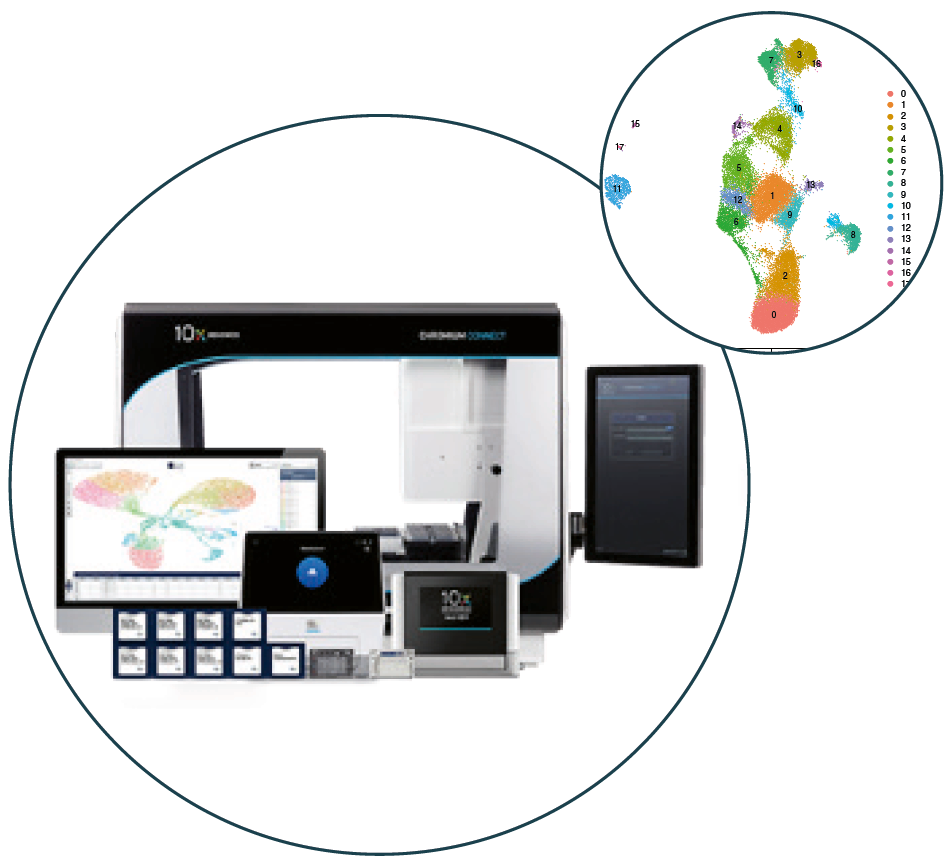
Transcriptomics (scRNA-seq)
Overview We provide services for high-throughput single-cell mRNA sequencing using nanodroplet-based 10X Genomics’ platforms. This technology allows cell capture of up to 20,000 single cells per sample, with up to 80% capture efficiency. We also provide 10X Genomics’ mRNA-seq analysis for fixed cells where cells are formaldehyde-fixed and can be stored up to 6 months before processing. 4 or 16 samples, containing 40 000 - 128 000 cells respectively, can be multiplexed to each sequencing library, making the protocol a good option for bigger projects. Sample requirements Single-cell suspension from high-viability fresh, frozen or methanol fixed human, mouse, rat, plants and other model organisms can be used for standard mRNA-sequencing. Fixed RNA profiling kit is compatible with human and mouse cells. Read more from 10 X Genomics’ webpageEpigenomics (scATAC-seq)
Overview Assay for Transposase-Accessible Chromatin using sequencing (ATAC-seq) is an analysis method that allows detection of open chromatin sites, such as promoters and regulatory areas, at a whole genome-wide level. We provide 10 x Genomics’ platform for ATAC-seq analysis at a single-cell resolution as well as multiomics application combining ATAC-seq and transcriptome analysis. Sample requirements Assay is optimized for human and mouse cells. Nuclei suspension from fresh or frozen cells or tissue is needed. See more details from here: 10 X Genomics Single Cell atac & 10 X Genomics’ Chromium Single Cell Multiome ATAC + Gene ExpressionImmune receptor sequencing
Overview We provide 10 X Genomics’ multiomic option for immune profiling. Full length V(D)J segments of B- or T-cell receptors can be analyzed in combination with full transcriptome or gene expression panel to identify for example immune cell clonality, diversity and antigen specificity, on a single-cell level. Cell surface protein analysis of hundreds of different cell surface proteins can be combined to give even more complete picture of immune cell repertoire. Sample requirements Single-cell suspension of high-viability fresh or frozen human or mouse cells can be used. Cells can be labeled with compatible oligonucleotide barcoded antibodies and/or peptide–MHCs in case cell surface protein detection or antigen binding analysis is of interest. See more detailed instructions from here Read more from 10 X Genomics’ webpageProteogenomics
Overview Single-cell gene expression analysis can be combined with cell surface protein detection using Biolegend’s TotalSeq feature barcoding antibodies. Cells can be stained with oligonucleotide barcoded antibodies or peptides and those oligonucleotide barcodes can be sequenced together with transcriptomes to give a more complete picture of individual cells. Hundreds of different cell surface proteins can be analyzed from a single sample. Sample requirements High viability, antibody- or peptide-stained cells, should be submitted as aggregate and debris free single-cell suspension. See more detailed instructions from here. Read more from 10 X Genomics’ webpage & more information about Totalseq antibodies and antibody staining protocol
Transcriptome-wide gene expression profiling in tissue context
Overview We offer 10 X Genomics’ Visium V2 and Visium HD applications for spatial transcriptomics analyses. The methods are based on positionally barcoded custom sample slides. The Visium V2 slide has capture areas of either 6.5 mm x 6.5 mm or 11 mm x 11 mm. The areas have barcoded spots of 55 µm with 100 µm center-to-center distance. Each spot features unique PCR barcodes, allowing spatial transcriptomics analysis to be performed in whole-genome wide level. The Visium HD Spatial Gene Expression slides contain 6.5 x 6.5 mm capture areas with a continuous grid of oligonucleotides arrayed in millions of 2 x 2 µm barcoded squares without gaps, achieving single cell–scale spatial resolution. The data is output at 2 µm, as well as multiple bin sizes. The 8 x 8 µm bin is the recommended starting point for visualization and analysis. Sample requirements Visium: We recommend using FFPE samples, freshly sectioned before the analysis. Optimal tissue thickness depends on the tissue type, but 10 um is optimal for most tissues. Before starting the Visium analysis, RNA quality will be measured using RNA extraction and capillary gel electrophoresis. Link to Visium
Mass Cytometry
Overview Similar to traditional fluorescence-based flow cytometry, mass cytometry allows multiple cellular parameters to be measured simultaneously. Instead of the fluorochromes used in flow cytometry, mass cytometry is based on heavy metal reporter ions. This allows the quantification of up to 45 cellular parameters simultaneously with hardly any overlap. Thus, mass cytometry or cytometry by Time of Flight (CyTOF) adds new dimensions to the study of cellular heterogeneity and diversity. Link to service
We work in collaboration with the Medical Bioinformatics Centre to develop data analysis solutions for single-cell and
spatial transcriptomics data. Please contact mbc [at] utu.fi for more information.
In addition, several online tools for data analysis and visualisation are available. These include for example:



